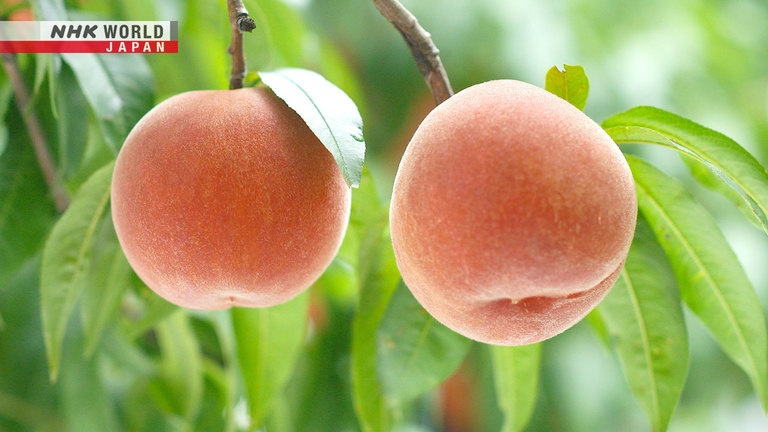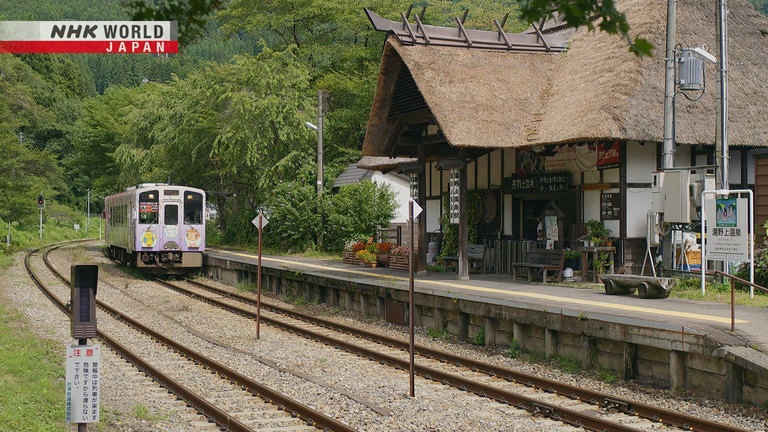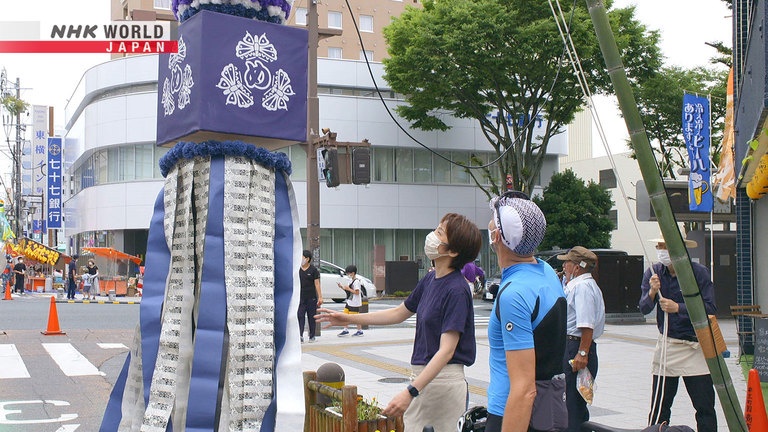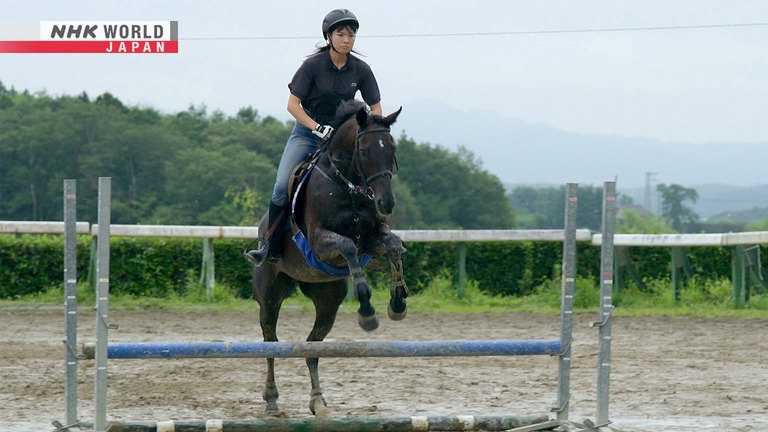Fukushima - Taking Life Day by Day
Fukushima Prefecture, with its beautiful mountains and coastline, is home to people who have survived disaster and come out stronger. We meet a peach grower thriving again after the great 2011 quake, a family that rebuilt their seaside hotel destroyed by the tsunami, shopkeepers organizing a summer festival after a two-year pandemic gap, highschoolers continuing Fukushima's samurai horse riding legacy, and three women friends who have staffed a tiny country station together for 35 years.




Transcript
The best way to discover little-known sights and make even familiar places feel brand new, is to go exploring by bicycle.
Today we're going to Fukushima, a region with incredibly varied scenery
- everything from deeply forested mountains to a glorious coast on the Pacific.
People in Fukushima are known for their fortitude
- a strength born from overcoming setbacks and disasters.
Well done!
I was born in Fukushima and I've
lived here all my life. I just love this place.
As the pandemic subsides, Fukushima's summer festivals are returning.
Here we go.
What an amazing sensation.
The region's young people are its hope for the future.
We have to care for our horses.
They do all the work.
Come with us now, on a four-day, 350-kilometer ride through Fukushima.
We've come by Shinkansen to Fukushima City, population 300,000.
Good morning.
So today we've come up from Tokyo to Fukushima.
This is Zac Reynolds, from Australia.
Zac works for a cycle manufacturer,
and has already explored much of Japan by bicycle.
So Fukushima is less than 2 hours from Tokyo,
and I haven't really been up here much before, just in the city around here.
So I got myself a map.
And we're going to go and have a look at the coastal area and see how that is now,
and then have a look at some of the inland mountainous areas as well.
Okay, it looks good.
Let's go.
On the first day, Zac will ride across the northern part of Fukushima.
Day two takes him down the coast,
the area that suffered most from the giant earthquake and tsunami of 2011.
On day three he'll ride inland into the mountains,
and on the final day he'll end the trip on Mount Azuma-kofuji.
Looks like an apple orchard on the left here.
Ten kilometers from Fukushima station, and Zac is cycling through a fruit growing area.
Looks like some nashi here.
Starting to see some more orchards up in this area.
Zac's spotted an orchard where you can pick your own fruit.
Hopefully we can see what kind of fruits are in season at the moment.
- Hello!
- Good morning!
- I see you have loads of peaches.
- Don't worry. I'll sell them all.
- Are they all from around here?
- Of course! Ripened by the sun, picked with love.
It's the most important thing.
And your clothes are all peach too.
- Showing your love for this fruit?
- You guessed it.
Gregarious and chatty with his customers,
Sato turns serious when caring for his beloved peaches.
Unlike most Japanese growers, Sato doesn't cover his peaches with protective bags.
Bathed in sunlight, they develop a beautiful color.
- I'll be as gentle as I can.
- That's the way.
- Well done!
- It's beautiful.
- The color is so deep.
- You chose a nice one.
Sato demonstrates the local way to eat a peach.
I cut in until I hit the pit.
Then I slice all the way round.
Now I don't need the knife anymore.
- Just twist and open.
- I've never seen that before.
Very good!
- A nice clean cut.
- Better than I could.
I don't think I've ever eaten a peach straight off the tree this fresh.
It's still really firm, but still juicy as well.
It's not too sweet and not too soft, but it's really full of flavor.
The orchard has been in Sato's family for four generations.
But this almost 120 year legacy was nearly wiped out by the 2011 earthquake.
After the meltdown at Fukushima Daiichi nuclear plant, tourism here collapsed.
Sato lost over 90 percent of his customers.
I asked everyone what we should do.
Our business had really hit rock bottom.
That meant there was nowhere to go but up.
So we decided we just had to carry on.
We gritted our teeth and got back to work.
They looked for new ways to make the orchard more appealing to visitors.
One idea was a cafe in the orchard, serving desserts made with different fruits each season.
First the quake, and now the pandemic.
It must have been hard to keep going?
I've lived here all my life. I just love this place.
I want everyone to share my love for Fukushima.
I'll never give up trying for that.
It's beautiful sunny weather this morning.
Should be a good day.
Zac's now riding east, towards the coast.
So we've come down out of the mountains now and riding along this nice gentle river.
We've come to the town of Sōma.
Definitely a nice view from up here.
This has always been a prosperous coast, the sea here teeming with fish.
Zac is more than ready for lunch now, and he's found the perfect spot, overlooking the bay.
This is it.
- What a lovely view.
- Thank you.
I can see the whole bay.
- Look at those rocks!
- The nearest one is Mojishima.
And the far one is Okigashima.
- Very strange shapes.
- Carved by the waves and wind.
Sakawaki Tadao inherited this hotel from his parents.
He runs it with his wife Yoneko.
The view over Matsukawa Bay has always been considered one of Japan's finest,
and this hotel is ideally placed to enjoy it.
Sorry to keep you waiting.
The lunch menu changes with the seasons,
but always features locally-caught seafood.
- These are my daughters.
- They look just like you.
This is miso soup with clams.
- He caught the clams yesterday.
- This all looks great.
I have to start with your clams.
Nice and plump. Fresh is certainly best.
Next...
- Green nori seaweed.
- This area has always been famous for nori.
This is excellent too.
Just the right amount of seasoning
to let the seaweed's own flavor shine.
You must be very happy
to get everything from the bay down below.
And I'm always pleased to welcome visitors
here to enjoy the beauty of Matsukawa Bay.
There's no place like it.
This family also suffered in 2011,
when the tsunami completely destroyed their hotel.
Sakawaki refused to give up.
It took nine long years, but he managed to rebuild everything.
Today, his eldest daughter Itsuko welcomes visitors at the hotel's front desk.
Desserts are made by the younger daughter, Shōko, who trained as a pastry chef.
They're both fully committed to helping their parents make a success of the restored hotel.
I call this cheesecake "Starry Skies."
Looks amazing. I can't wait.
One of Shoko's favorite designs, this was inspired by the summer night sky over the sea off Soma.
It's incredibly soft.
And the touch of lemon is perfect.
- I bet this makes your customers smile.
- So glad you like it. Thank you very much.
Sometimes I worry about what lies ahead.
But there's always someone to talk to and share
my concerns.
The family makes a great team.
I might sometimes speak my mind too much,
but I know they've always got my back.
What more can I say?
- What can I say?
- You already said that.
I'm so grateful to our daughters.
They work so hard to keep things going.
I hope we'll always keep doing this as a family.
What will the future hold for this family hotel by the sea?
As Zac continues south along the coast,
he sees more of how the earthquake and tsunami changed this landscape.
Looks like a lot of new solar panels here, as well as the wind power generators.
You can see some construction up here.
Even today, 11 years after the disaster, the reconstruction work is far from complete.
Hello there!
So we're coming into the center of Namie Town.
After the nuclear accident following the 2011 tsunami, the town's residents were ordered to evacuate.
It was only declared safe to return in 2017,
although there are some areas that still remain off limits.
Today we're going to visit this new town center that's just been opened.
Fully opened just last year,
Michinoeki Namie is a shopping mall showcasing local products.
I can see a lot of pottery lined up inside in here.
Let's go and have a look at that.
Look at all these. They all have a horse motif on them.
Oh, look at this.
You can see some holes in it here.
It looks like a double-layered structure here.
Ah, hello!
Hello.
Is all this pottery locally made?
The craft is named after one of the town's districts.
It dates back 300 years.
This is a famous old design, showing a horse and the Pacific ocean.
The holes suggest birds flying between the waves.
I've cut this to show how it's made.
There's an outer and an inner layer that
only join together around the lip of the mug.
They're made separately then joined?
It acts as an insulator, so you may not realize
how hot the drink is until you take a sip!
Are you a potter too?
Yes, these are all my work.
Onoda is a 13th generation Obori-soma potter.
After the nuclear accident, he had to leave,
abandoning both home and workshop.
What was it like here before the quake?
There was a greengrocer on this corner.
We had a watch shop here, and a liquor store.
And over there was a pottery store.
It sold locally made ceramics too.
I hated to think of Obori-soma ware dying out.
It has such a history,
I felt I had to do everything I could to keep it alive.
Even though restrictions have now been lifted the town's recovery is going slowly,
so Onoda still lives and works elsewhere.
But, determined to preserve the Obori-soma ware tradition,
he sells his pottery and teaches classes at the new mall.
Eleven years seem to have passed in a flash.
This is my home, where I was born.
I'll try anything to get people to return to the area.
You just have to keep working at it.
It's taken years to get to this point,
but this is a community that finally feels on the way to recovery.
Early morning, and Zac is now in Iwaki, getting his bike ready for the third day.
Looks like they're getting ready for some kind of festival here.
Wow, we've got some big decorations up here.
Check these out.
Three colors.
Tanabata is a major festival held in summer throughout Japan.
These giant decorations suspended from bamboo poles are put up by local shop owners.
People write wishes and tie them to clumps of bamboo grass.
Looks like lots of kids are writing their messages on here.
A couple of little pictures here.
He wants to become an ice cream maker.
Hello. Are you about to raise it up?
Yes, we're ready now.
It looks heavy.
No, it's actually quite light.
Here we go!
A bit higher. OK!
Kitabayashi Yuko runs a local Italian restaurant.
These holes are for the bamboo poles.
They're only used for the Tanabata festival.
Iwaki has been holding a Tanabata festival for about a century.
The event was cancelled for the last two years due to the pandemic,
and everyone is very excited it's finally happening again.
OK! Stop!
Watch out! Coming through!
It's OK. It just fits through.
Kitabayashi's parents ran a clothing store here,
but like many of Iwaki's young people, she left to work in Tokyo.
Seeing her town decline, she came home again to open a restaurant.
It only happens once a year, but I think
this festival is very important for our town.
It gives our community a sense of identity.
As the streets start to fill up with spectators,
the shop owners feverishly rush to complete their preparations.
Slide the bottom in.
Now everyone push up!
Altogether now!
It's in!
That looked like a lot of work.
Yes.
You must be looking forward to all the visitors.
It's a chance to meet old friends again.
We were worried how many would come,
with the pandemic still not really over.
So I was really pleased to see all these crowds.
This is my wish.
After a two year gap the crowds are back, bigger than ever.
The festival has drawn about 100,000 visitors.
Zac is now riding west from Iwaki towards the town of Kagami-ishi.
A guy fishing in the river here.
Look at this. See the forest here?
So beautiful and cool under here...,
especially on a hot summer's day.
Zac has come down into a small farming village.
Cattle yard here.
Quite a few cattle.
Ah, here it is.
He's going to visit the local high school.
Hello!
Thanks for showing me around.
You're welcome.
Kasai is taking Zac to see a specialty of this school - their horse riding club.
Hello!
These first-year students
are still learning to work with horses.
Students learn both dressage and showjumping skills.
This school club, which currently has 11 members,
has twice won national championships.
Fukushima is historically famous for horse breeding,
with a deep connection to horses dating back to the samurai era.
- Hello!
- Hello!
- My name's Zac.
- I'm Maria.
- She's head of the riding club.
- Cool.
Inoue Maria joined the club because of her love for horses,
and quickly discovered she had a natural talent for riding.
You don't suddenly become a good rider.
You have to work at the basics, day after day.
Do that, then one day you'll get it.
The most important thing
is to get to know your horse.
Through daily grooming and hands-on care,
students develop a close rapport with their horses.
We take good care of our horses.
After all, where would we be without them?
I even like sound of the word "horse."
I'm just crazy about them.
Maria decides she can trust Zac with her favorite horse.
- Are you OK?
- It's so high!
Here we go.
- What an amazing sensation.
- Really?
You'd need daily practice to get used to this.
That's right.
Hold the reins with both hands, thumbs on top.
- You got it! That's the basic grip.
- OK!
- Try relaxing your shoulders.
- OK.
Be sure to pat and thank your horse.
Thank you. That was such fun!
Good job. And I could tell you were having fun.
You don't need to pretend.
No – riding is all about having fun.
Do you plan to work with horses for a living?
I hope to become a racehorse trainer.
I'll probably have to move to Hokkaido for that.
That's a long way from home.
Won't you feel lonely?
- No, it'll be fun.
- You just love working with horses.
Absolutely!
The view from high in the saddle - an inspiration to take on new challenges.
It's the last day and Zac is climbing yet again.
Clearing this pass will bring him to Yunokami Onsen.
There's not much up here apart from forest.
I made it past 822m, elevation of about 400m gained.
I'm going to enjoy this downhill.
Feel that cool breeze.
Wow, look at the view.
Zac is now in the hot-spring resort of Yunokami Onsen.
You got a big wooden bridge.
Looks like it's under construction.
Wow. Check out this station here.
Traditional thatched roof.
Never seen a station like this before.
Looks pretty old, this station.
Good morning!
Hello.
What an amazing place.
How long have you worked here?
About 35 years.
Three of us run the place.
My bosses are in there. Let me call them over.
Why are you calling me boss?
Well, you joined the company first.
But you're the boss today.
Nice to meet you.
May I ask your names?
Boss, you go first.
I'm Shiraishi Minako.
Station master Shiraishi.
I'm Tamagawa Eiko.
Today I'm running the station kiosk.
And I'm Watanabe Katsue.
You seem like great friends.
The Aizu Railway opened in 1987.
Yunokami Onsen station was designed to attract tourists
with its charming old-style architecture and thatched roof.
Shiraishi and her two friends were sent by the Aizu tourist association to run the new station.
35 years later, they're still here,
taking turns at selling tickets and managing the station kiosk.
This is unusual. An open hearth in a station.
It's to help preserve the building.
Insects will attack thatched roofs if they stay damp.
The smoke coats the thatch and repels bugs.
It's colored the walls too.
When we started here they were white.
35 years of smoke, and they're pure black.
The best-selling item when the station opened was this local yokan,
a firm jelly made from sweet bean paste.
The original makers retired, so the three friends learned how to make it themselves,
as yet another of their many occupations here.
It's a beautiful color.
Delicious. I can really taste the walnuts.
And it has just the right amount of sweetness.
- Old photos?
- Yes.
Ah, here's a good one.
The three of us back then.
Look at that!
- We haven't changed a bit.
- Not a bit!
Always laughing, even back then.
Three lives, centered on this little country station.
Over the years, they married, raised children,
cared for aging parents, but the station was always there for them.
A place that never changed, a place to be with the friends they trusted most in life.
This job has become a major part of our lives.
We sometimes have to take a break,
but mostly we try to be here every day.
We'll probably still be here next time you come.
Might be walking with a stick, though.
I'd be very happy to see you all.
Thank you very much!
Goodbye! Take care!
Waved off by the three friends, Zac takes the train from Yunokami Onsen.
The train has brought Zac over to the next valley.
From here, he'll ride through the foothills of Mount Bandai to his goal.
Nice view here.
The road is now about 1,000 meters above sea level.
Ah, look at this here.
You can see the smoke coming out.
Zac has reached his goal.
The 1,707-meter Mount Azuma-kofuji.
These bare rocky peaks are the remains of ancient volcanoes.
Is this the top?
Wow, look at this here,
the sea of clouds over to the north and then looking back down towards Fukushima City where we started.
Wow, what a beautiful view.
What an awesome place to finish this trip.
Meeting all the people in these different areas that have had these common hardships but various effects.
But seeing the way that everybody has dealt with the hardships that come.
And not just the first, the biggest one.
Often it seems like after one disaster,
take a couple of steps forward and then you have to take another step back when something else comes.
And take another step forward and then something else comes as well.
But just the way everybody deals with it, working together to continue.
You can see the forward thinking attitude of the people and banding together
to take whatever comes in their stride and just move on and make things better.
Even in the hardest times, people here in Fukushima never lose their optimistic attitude,
battling on with a smile to build a better future.